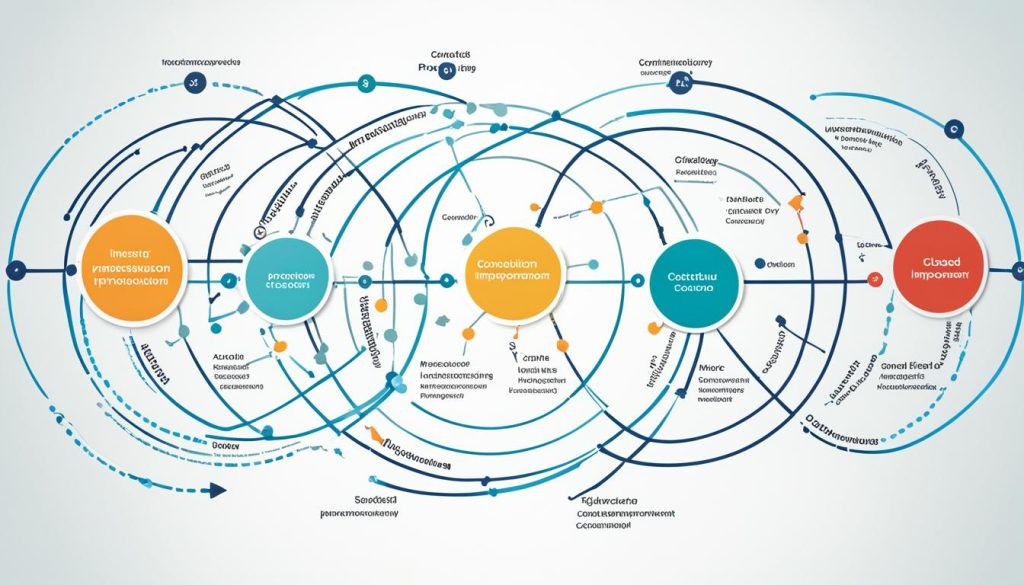As a blogger, you know that technical issues and bugs are part of the job. But what if you could manage these problems better? This guide will show you how to handle common technical problems on platforms like WordPress and Blogger.
Did you know 70% of websites face at least one technical issue monthly? This fact highlights the need for a strong system to tackle these issues. Are you ready to improve your blog’s technical side and enhance user experience?
Next, we’ll cover how to set up a top-notch bug-tracking system. You’ll also learn about clear team communication and using the latest software to keep your blog running smoothly. Say goodbye to technical troubles and hello to easy blogging.
Understanding the Nature of Technical Glitches
In today’s digital world, technical glitches are a normal part of managing a blog. It might seem tough to deal with these common causes of blog technical issues. But, knowing what causes them is crucial for troubleshooting technical glitches. By being proactive and identifying the root of the problems, you can lessen their effects. This ensures your readers have a smooth experience.
Common Causes of Blog Technical Issues
- Faulty code: Poorly written or outdated code can lead to bugs and compatibility issues.
- Plugin conflicts: Incompatible or outdated plugins can interfere with your blog’s functionality.
- Server-side problems: Issues with hosting, bandwidth, or server configuration can cause site slowdowns or downtime.
- Theme-related problems: Poorly designed or incompatible themes can introduce a range of technical challenges.
- User-generated content: Malicious or improperly formatted user submissions can disrupt your blog’s stability.
Identifying the Root of the Problem
When you face a technical issue, it’s important to identify the root of the problems rather than just treating symptoms. This means going through a step-by-step troubleshooting process. This process includes:
- Conducting a thorough check of your blog’s code, plugins, and theme.
- Looking into your server’s performance and spotting any oddities.
- Reviewing user-generated content for security risks.
- Writing down the issue in detail, including any error messages or patterns.
- Isolating the issue by testing parts or going back to a known working state.
By being systematic in identifying the root of the problems, you can solve troubleshooting technical glitches. This approach helps keep your blog running smoothly for your readers.
| Common Causes | Impact | Potential Solutions |
|---|---|---|
| Faulty code | Bugs, compatibility issues | Code review, testing, and updates |
| Plugin conflicts | Functionality disruptions | Plugin audits, updates, or replacements |
| Server-side problems | Slowdowns, downtime | Server configuration, resource optimization |
| Theme-related problems | Visuals, layout issues | Theme compatibility checks, updates |
| User-generated content | Security vulnerabilities | Content moderation, input validation |
Implementing an Effective Bug-Tracking Method
Handling technical issues or bugs is key for a smooth-running blog. Using a good bug-tracking method is a simple way to do this. You can use a shared spreadsheet, bug-tracking software like Jira, or both.
It’s important to have a clear, structured way to track bugs. This lets your team see the status and progress of each bug. It helps them work more efficiently, making your blog better for users.
Advantages of a Structured Bug-Tracking System
- Improved Visibility: A centralized system keeps track of each bug’s status, making sure nothing is missed.
- Efficient Prioritization: You can see all open issues clearly, so you can fix the most important ones first.
- Enhanced Collaboration: A shared platform makes it easy for team members to talk and work together, keeping everyone on the same page.
Choosing the Right Bug-Tracking Tool
When picking a bug-tracking methods tool, think about how easy it is to use, how well it fits with your current workflow, and what kind of customization and reports it offers. Jira, Trello, and GitHub Issues are popular choices, each with their own benefits.
| Bug-Tracking Tool | Key Features | Pricing |
|---|---|---|
| Jira | Comprehensive issue tracking, project management, and agile planning | Starting at $7/user/month |
| Trello | Kanban-style boards, customizable workflows, and team collaboration | Free for basic, paid plans start at $5/user/month |
| GitHub Issues | Seamless integration with your GitHub repositories, lightweight issue tracking | Free for public repositories, paid plans for private repositories |
Using a good bug-tracking methods helps your team manage bugs better. It makes things clearer, improves how you work together, and makes your blog better for users.
The Importance of Clear and Structured Communication
Effective communication is key to solving technical blog issues. When documenting bugs, being precise is crucial. Make sure your team has a clear way to report technical problems. This ensures they capture all the important details.
Documenting Bugs with Precision
A good bug report should have these parts:
- Detailed description of the defect
- Step-by-step instructions to replicate the problem
- The environment in which the issue occurred (e.g., browser, operating system, device)
- The expected result and the actual outcome
- The priority or severity level of the bug
Add screenshots, video recordings, or code snippets to your report. This makes it easier for your team to understand the issue. Being precise helps fix bugs faster and gives your team a clear plan to follow.
Using a structured way to document technical issues helps you explain problems clearly. This makes bug reporting clear. It helps your team solve problems better and fix technical issues on your blog.
Leveraging Video Recordings for Enhanced Clarity
In the fast-paced IT world, it’s tough to document technical issues well. But, using video recordings can make things clearer and help solve problems faster.
Instead of just text reports, try using screen-share videos to show technical issues. This way, your team gets a deeper understanding of the problem. They can watch the video whenever it’s convenient for them, making sure they get every detail.
Also, video recording tools let you highlight important parts with drawing tools. This makes it easier for your team to see what’s wrong and fix it fast.
Using video to document technical issues, screen recording for bug reporting, and multimedia support for problem-solving can really help your team talk better. It cuts down on misunderstandings and makes fixing complex problems faster.

| Benefits of Using Video for Bug Reporting | Drawbacks of Relying on Text-Based Bug Reports |
|---|---|
|
|
Dealing with technical blog issues: Reviewing Bug Lists Regularly
Keeping your blog running smoothly means paying close attention to the technical side. A key part of this is checking your blog’s bug list often. By doing this regularly, you make sure all problems get fixed quickly. This stops them from getting worse or being missed.
Have your team meet up daily or weekly to talk about the bug list. This helps everyone feel responsible and understand the technical hurdles your blog faces. When you go over the list, follow these steps:
- Prioritize issues by how much they affect users and your blog’s performance.
- Assign tasks to team members who know how to fix each bug.
- Set clear deadlines for solving the bugs and keep an eye on how they’re doing.
- Discuss potential solutions and find ways to avoid similar bugs in the future.
Regularly checking your blog’s bug list helps you manage technical problems well. This keeps your blog running smoothly for users. It also shows you’re serious about keeping your blog reliable and high-quality for your readers.
| Key Metrics to Monitor | Optimal Ranges |
|---|---|
| Page Load Time | |
| Broken Links | |
| Plugin Conflicts | 0 active conflicts |
| Database Errors | 0 reported errors |
Starting with a Shared Spreadsheet for Bug Tracking
Managing technical issues or bugs on your blog often starts with a simple tool: a shared spreadsheet. This low-effort approach is great for documenting and tracking issues in your team. It’s a good starting point before moving to more complex tools.
Using spreadsheets for bug tracking lets your team quickly report, organize, and track technical problems. This simple bug management tool makes communication easy and keeps everyone informed. It helps solve problems before they get worse.
A shared spreadsheet is easy to access for team members. They can update it easily, making collaborative issue reporting smooth. This way, everyone knows the status of issues, helping solve problems more efficiently.
As your bug-tracking needs grow, you can switch to a more advanced tool. But starting with a spreadsheet is a good first step. It lays a solid foundation for handling technical issues on your blog.
| Feature | Spreadsheet | Dedicated Bug Tracking Software |
|---|---|---|
| Ease of Setup | High | Moderate |
| Collaboration | Good | Excellent |
| Reporting and Analytics | Limited | Robust |
| Integration with Other Systems | Moderate | High |
![]()
Structured Data: The Key to Team Visibility
When using bug-tracking tools, it’s crucial to make sure your data is structured well. This means having clear standards for reporting issues. You need to include enough details to recreate the bug, its severity, and how it might affect the business.
Maintaining Consistency Across Interfacing Systems
Keeping things consistent across all systems and teams helps with solving technical problems efficiently. As your blog and support grow, this structured data keeps everyone on the same page. It makes sure cross-team visibility is there, keeping track of bug reports.
Standardizing how you handle technical issues helps your team work better together. This means quicker fixes for bugs, making your blog better and more reliable.
Good bug tracking starts with how you organize and show your data. Spend time on clear data structures and processes. This unlocks the power of cross-team visibility, making your technical support smoother.
Using Clear Language in Problem Documentation
When tracking bugs and technical issues, clear and concise documentation is key. Clear problem documentation, concise bug reporting, and effective technical communication help your team quickly understand and solve problems.
Begin by giving a detailed description of the bug or technical problem. Explain what’s happening, including any error messages or unexpected behavior. Use clear language and avoid vague terms. Highlight how the issue affects your users and business to guide your team on what to fix first.
- Use simple, easy-to-understand language when describing the problem.
- Provide step-by-step instructions on how to reproduce the issue.
- Include relevant screenshots, screen recordings, or log files to supplement your written description.
- Clearly communicate the expected behavior and how the current behavior differs from it.
- Highlight any potential impact on your users or your business operations.
Documenting problems clearly and concisely gives your team all the info they need. This effective technical communication speeds up bug fixes and improves the user experience.
| Best Practices for Clear Problem Documentation | Benefits |
|---|---|
| Use simple, unambiguous language | Ensures the issue is understood clearly |
| Provide step-by-step reproduction instructions | Helps developers replicate the problem |
| Include relevant supporting materials | Provides additional context for the developers |
| Clearly communicate the expected vs. actual behavior | Helps the team identify the root cause of the issue |
| Highlight the potential impact on users and business | Enables the team to prioritize the fix accordingly |

Utilizing Dedicated Bug-Tracking Software Solutions
As your blog and team grow, moving from a shared spreadsheet to a dedicated bug-tracking software is key. Tools like Jira, Mantis, Redmine, and HP ALM offer a lot more. They have features like Agile-based workflow, automated alerts, and integrated reporting.
These technical issue management tools make it easier for your team to handle problems. They provide a single place for tracking bugs, tasks, and other issues. With automated reporting and customizable workflows, you can make sure nothing gets missed. Your team will be able to fix blog technical issues quickly.
- Streamlined bug-tracking software for managing technical problems
- Agile-based workflows and integrated reporting for enhanced visibility
- Automated alerts and notifications to stay on top of issues
- Scalable solutions that grow with your blog and team
Using dedicated issue tracking software means saying goodbye to the limits of a shared spreadsheet. It lets your team work better and tackle technical challenges more efficiently. Look into the technical issue management tools available and pick the one that suits your blog best.
Fostering Extreme Ownership Among Support Teams
When dealing with technical issues and bugs, a culture of team accountability for bug resolution works better than just technology. By letting your support team own the problems they find, document, and fix, you encourage a proactive, problem-solving mindset. This approach helps your organization.
One key lesson from Extreme Ownership is the value of shared responsibility for technical issues. Instead of blaming others or relying on a single team, push your support staff to own the problems they see. This change leads to more proactive solving, better communication, and stronger teamwork.
- Set high standards and clear expectations for your support team’s performance in resolving technical issues.
- Ensure that each team member understands the mission and their role in achieving it.
- Simplify plans and prioritize tasks to maintain focus and drive progress.
- Empower your team members to take initiative and make decisions within their areas of responsibility.
- Emphasize the connection between discipline and freedom, as a well-trained, self-motivated team can operate with greater autonomy.
By promoting a culture of extreme ownership, you can tap into your support team’s collective smarts and commitment. This leads to quicker bug fixes, happier customers, and a stronger sense of team accountability.

| Characteristic | Description |
|---|---|
| Team Accountability | Support team members take full responsibility for identifying, documenting, and resolving technical issues. |
| Proactive Problem-Solving | Employees adopt a mindset of anticipating and addressing problems before they escalate. |
| Shared Responsibility | The entire support team collaborates to ensure technical issues are addressed effectively. |
Exploring New Software Options for Bug Tracking
The world of bug-tracking software is always changing. It’s important to keep up with the latest tools and what they can do. Tools like Jira, Mantis, Redmine, and HP ALM offer features that can make your blog’s technical support better. When looking at bug-tracking options, think about how easy they are to use, how well your team can work together, and how they fit with your current systems.
Popular Bug-Tracking Tools and Their Features
There are many latest issue management tools that can improve your technical support. Let’s look at some top bug-tracking software and their main features:
- Jira: It has strong Agile-based workflows, customizable dashboards, and works well with other development tools.
- Mantis: It’s easy to use, tracks issues well, and has flexible reporting.
- Redmine: It’s a full project management tool with task management, time tracking, and issue categorizing.
- HP ALM: It has advanced test management, defect tracking, and traceability to make software development smoother.
When comparing technical support solutions, think about if they fit your blog’s needs, how your team works, and your current setup. Choosing the right new bug-tracking software can really help you manage and fix technical issues better.
Implementing a Closed-Loop System for Bug Resolution
Keeping your blog running well needs a detailed plan for handling technical problems. A great way to do this is by using a closed-loop system for fixing bugs. This method includes three main steps: picking what to fix, promising when it will be done, and keeping users informed.
First, sort bugs by how serious they are and how they affect your blog. Focus on the most critical ones first to keep your blog running smoothly. This way, you make sure you’re tackling the biggest problems first.
- Prioritize bugs based on severity and impact
- Commit to a clear timeline for closing each issue
- Effectively communicate the status and resolution to users
Then, set a timeline for fixing each bug. Deadlines help you work efficiently and keep your blog running well. This shows your team’s commitment to a great user experience and helps your team work better together.
It’s also key to talk to your users about the bugs you’re fixing. Keep them updated on what’s happening and how you’re solving the problems. This makes them trust you more and feel like you care about their experience.
This detailed closed-loop system helps manage technical issues better, making your blog more reliable for users. It lets your team focus on what needs to be done and talk about it clearly. This makes your blog better overall.

| Bug Severity | Resolution Timeline | Communication Approach |
|---|---|---|
| Critical | Within 24 hours | Immediate updates to users |
| High | Within 3 business days | Weekly updates to users |
| Medium | Within 1 week | Monthly updates to users |
| Low | Within 2 weeks | Quarterly updates to users |
Integrating User-Generated Bug Reports with Internal Trackers
Keeping a blog running smoothly is key to a great user experience. It’s important to merge user-reported bugs with your tracking systems. This way, you can catch and fix technical issues fast.
Popular tools like Jira and Trello make it easy to link user feedback with your system. This helps your teams work together better, using user feedback to improve your site.
- Create a simple way for users to report bugs, encouraging them to share any tech problems they find.
- Link your bug reporting tool with your internal system for smooth info flow.
- Train your support team to quickly handle user reports, keeping users updated.
- Look at bug reports to spot common issues and plan for future updates.
| Key Benefits | Improved Customer Satisfaction | Enhanced Incident Response | Streamlined Collaboration |
|---|---|---|---|
| Prompt resolution of user-reported issues | Addressing problems quickly and effectively | Efficient triage and prioritization of bugs | Seamless information sharing between support and development teams |
By linking user feedback with your tracking, your blog gets a strong support system. This keeps users happy and your site running well.
Leveraging Error Tags for Efficient Alert Management
Managing technical blogs can be tough. Using error tags with customizable thresholds is a smart move. This way, your team gets alerts only for the big issues. They can then focus on the most urgent problems first.
This method helps avoid alert overload. Your team won’t be swamped with too many notifications. They can concentrate on what really needs their attention. By setting alerts based on thresholds, you keep track of technical errors and bugs well. This shifts your approach from reacting to acting ahead in blog maintenance.
With this strategy, your support team can quickly tackle issues before they get worse. This improves the user experience and makes your blog more reliable. It also helps build a strong brand online.
Source Links
- https://jamie-burns.medium.com/a-short-guide-to-fixing-bugs-in-software-764fc31bb0e5
- https://www.forbes.com/sites/forbestechcouncil/2020/12/22/14-pro-tips-for-efficiently-tracking-tech-bugs-and-issues/
- https://workplace.stackexchange.com/questions/187235/how-should-i-deal-with-being-blamed-for-a-production-bug

